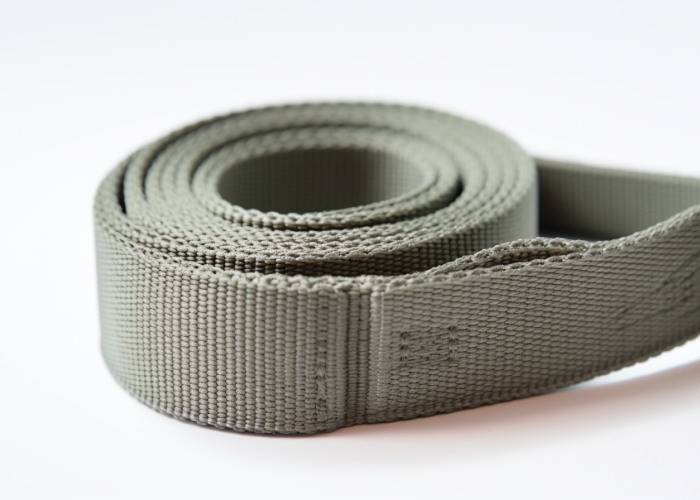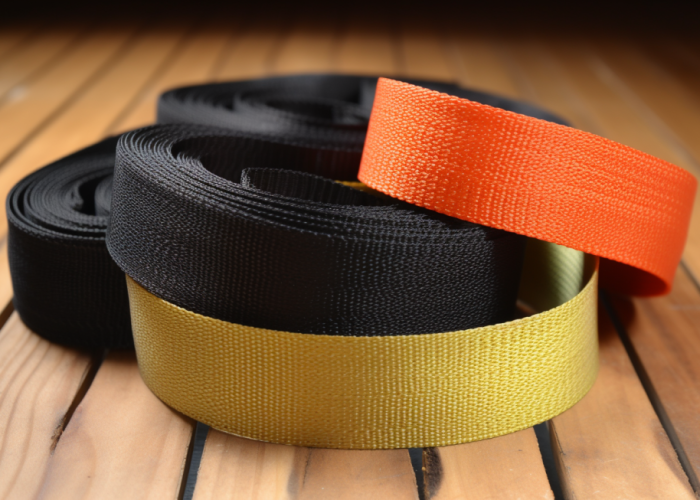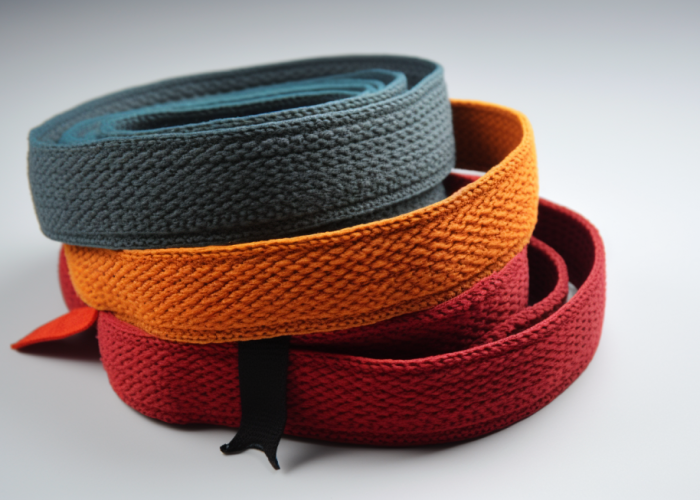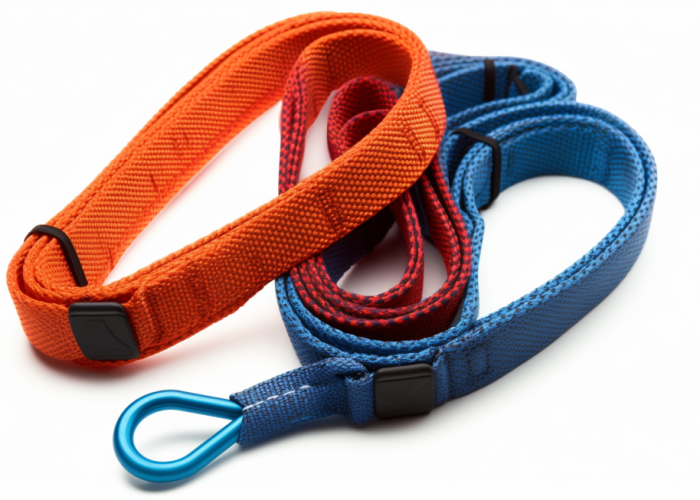When designing products with nylon webbing components, understanding material behavior under various conditions is critical for long-term performance. As manufacturers with over 15 years of specialized experience producing custom webbing for industrial applications, we’ve conducted extensive testing on shrinkage factors across varying environmental conditions and manufacturing methods.
Yes, nylon webbing does shrink typically between 3-7% when exposed to temperatures above 180°F (82°C) or high moisture environments. The degree of shrinkage varies based on specific nylon type, with Type 6,6 nylon showing approximately 40% less shrinkage (1.8-4.2%) than standard Type 6. This natural property stems from nylon’s semi-crystalline polymer structure, which contracts when exposed to heat or significant moisture due to molecular rearrangement.
Learn what causes nylon webbing shrinkage, how different nylon types compare, and the manufacturing techniques that minimize shrinkage—essential insights for product developers focused on component stability.


Webbing manufacturing expert with 15+ years of experience helping product developers build high-performance straps for industrial, medical, and outdoor use.
Nylon webbing shrinks when exposed to heat because of the semi-crystalline structure of nylon polymers. When heated above 180°F (82°C), the molecular chains that were previously stretched during manufacturing begin to relax and return to their more compact natural state. This molecular rearrangement causes the overall dimensions of the webbing to contract, with the most significant shrinkage occurring in the length direction.
During production, nylon fibers are stretched to create alignment and increase strength. This stretching places the molecular chains under tension, creating what manufacturers call “memory” in the material. When later exposed to heat, these molecular chains attempt to return to their pre-stretched state, resulting in dimensional changes.
Heat-induced shrinkage is most noticeable in applications where precise dimensions are critical, such as in automotive safety components, aerospace applications, and load-bearing equipment. Controlled heat exposure during production can help stabilize the material by releasing some of this built-in tension before the product reaches end-users.
The percentage of shrinkage in nylon webbing typically ranges from 3-7% when exposed to temperatures above 180°F (82°C) or high moisture environments. This variation depends primarily on the specific type of nylon, with Type 6 experiencing 5-7% shrinkage while Type 6,6 shows significantly less at 1.8-4.2% under identical conditions.
Our laboratory testing reveals that shrinkage is not uniform across all dimensions. Lengthwise shrinkage (along the warp direction) is generally 2-3 times greater than width shrinkage (weft direction). For example, standard Type 6 nylon webbing may shrink 6% in length but only 2% in width when subjected to 200°F (93°C) for 30 minutes.
Factors influencing the exact percentage include initial tension applied during manufacturing, thickness and width of the webbing, weave pattern and density, duration of heat exposure, and presence of moisture during heating. These variables necessitate specific testing for each webbing specification to accurately predict dimensional changes.

Heat affects nylon webbing during manufacturing by influencing molecular alignment, crystallinity, and dimensional stability. When nylon is heated above 180°F (82°C) during processing, the polymer chains become more mobile, allowing them to align in the direction of applied tension, which increases strength but creates potential for future shrinkage.
Temperature control is critical during the manufacturing process. Our production facilities maintain precise temperature zones throughout webbing formation:
Improper heat management can lead to inconsistent shrinkage behavior. Too much heat can degrade the polymer chains, reducing tensile strength, while insufficient heat fails to properly align the molecules, resulting in webbing that will experience excessive shrinkage later.
Our manufacturing process incorporates strategic heat exposure phases to release built-in tensions before the webbing reaches customers, ensuring dimensional stability even when subjected to moderate temperature variations during use.
Yes, moisture causes nylon webbing to shrink through a process called hydrolysis, where water molecules interact with the polyamide structure. Our testing shows that exposure to high humidity (above 85%) can cause dimensional changes of 2-4% even without elevated temperatures. When moisture and heat combine, shrinkage can increase by an additional 1-3%.
Nylon is hygroscopic—it naturally absorbs water from the environment. Our laboratory data indicates that nylon can absorb up to 8.5% of its weight in moisture at 100% relative humidity, with each 1% increase in moisture content potentially contributing 0.3-0.5% to overall shrinkage.
The combination of moisture and tension creates particularly challenging conditions. When wet nylon dries under tension, internal stresses develop within the material structure. These stresses can later cause unpredictable dimensional changes when the webbing is subjected to varying environmental conditions.
To counter moisture-related shrinkage, we employ specialized pre-conditioning treatments that stabilize the molecular structure before the webbing reaches end-users. These treatments involve precisely controlled wet-heat cycles that allow the material to reach equilibrium before final processing.

Type 6,6 nylon has the lowest shrinkage rate among standard nylon varieties, exhibiting approximately 40% less shrinkage (1.8-4.2%) than conventional Type 6 nylon when exposed to identical heat and moisture conditions. This superior dimensional stability stems from Type 6,6’s longer polymer chains and additional hydrogen bonding that create a more stable molecular structure.
High-Tenacity Nylon 6 offers the next best performance, with shrinkage rates 25-30% lower than standard Nylon 6. This improved stability comes from enhanced molecular orientation achieved through specialized drawing processes during manufacture, resulting in more aligned polymer chains that resist rearrangement.
Nylon 4/6 provides exceptional thermal stability with shrinkage rates as low as 1.2-3.5% at temperatures up to 350°F (177°C). Its molecular structure contains more amide groups per chain length compared to other nylon types, creating stronger intermolecular forces that maintain dimensional stability even at elevated temperatures.
Nylon copolymers, especially those incorporating aromatic components, demonstrate superior resistance to thermal shrinkage. These specialized formulations maintain dimensional stability with less than 2% shrinkage even after extended exposure to 250°F (121°C).
Manufacturers can prevent nylon webbing shrinkage through pre-conditioning treatments, heat stabilization, and specialized finishing processes. Our production protocol includes a crucial pre-shrinking heat treatment where webbing is exposed to temperatures 15-20% higher than expected in its end-use environment, allowing controlled shrinkage to occur before reaching customers.
Pre-conditioning involves these key steps:
Our climate-controlled production facilities maintain consistent temperature and humidity levels throughout the manufacturing process, preventing the introduction of variable moisture content that could contribute to inconsistent shrinkage behavior.
Chemical treatments can enhance dimensional stability by forming cross-links between polymer chains, restricting their movement when exposed to heat or moisture. These treatments can reduce overall shrinkage potential by 40-60% compared to untreated nylon webbing.
Optimal storage conditions to minimize nylon webbing shrinkage include maintaining constant temperature between 65-75°F (18-24°C), relative humidity of 40-60%, and storing rolled material horizontally rather than hanging vertically. These conditions prevent the introduction of environmental stresses that could trigger dimensional changes.
Temperature fluctuations pose significant risks to dimensional stability. Our testing demonstrates that rapid temperature cycles can cause cumulative shrinkage even when peak temperatures remain below the typical 180°F (82°C) threshold. Storage areas should be insulated from external temperature variations and direct heat sources.
Humidity control is equally important for maintaining dimensional stability. Storage facilities should employ dehumidification systems in humid climates to keep relative humidity below 60%. In extremely dry environments, moderate humidification helps prevent excessive drying that can alter the material’s equilibrium moisture content.
Physical storage configuration recommendations include:

Testing nylon webbing for potential shrinkage requires controlled exposure to heat, moisture, and tension followed by precise measurement of dimensional changes. Our standard protocol involves marking test specimens at precise intervals, subjecting them to various environmental conditions, then measuring the percent change in dimensions.
Heat exposure testing provides the most direct assessment of shrinkage potential. We expose sample webbing to temperatures ranging from 180-350°F (82-177°C) for periods of 30-120 minutes, documenting the relationship between temperature, exposure time, and dimensional change.
Moisture-related testing involves:
Combined heat and moisture testing provides the most comprehensive evaluation. Our advanced environmental chambers can simultaneously control temperature, humidity, and tension while continuously monitoring dimensional changes, simulating real-world conditions more accurately than single-variable testing.
For customers requiring guaranteed dimensional stability, we offer customized testing programs that replicate their specific application environments before full production begins.
Understanding and controlling nylon webbing shrinkage is essential for product reliability and performance. Our manufacturing processes incorporate pre-conditioning treatments, precise temperature control, and specialized testing protocols to deliver dimensionally stable webbing. By selecting appropriate nylon types and implementing recommended storage practices, our customers can minimize shrinkage issues and ensure consistent performance across applications and environments.
Pre-conditioning treatments prevent nylon webbing shrinkage by exposing the material to controlled heat (230-250°F) and moisture cycles during manufacturing. This process allows for controlled pre-shrinkage, releases molecular tension, and stabilizes the polymer structure. Additional preventive measures include heat-setting, chemical stabilizers, and maintaining consistent environmental conditions throughout production.
Temperature affects nylon webbing during manufacturing by influencing molecular alignment, crystallinity, and dimensional stability. Proper temperature control is critical at each stage: extrusion (490-530°F), cooling (controlled gradual rate), heat-setting (350-390°F), and final tensioning (lower temperatures). Inconsistent temperatures lead to unpredictable shrinkage behavior and reduced tensile strength.
Yes, heat solutions and fiber blending can reduce nylon shrinkage. Heat solution treatments using controlled steam exposure pre-shrink the material under tension. Incorporating low-shrinkage fibers like polyester (reducing shrinkage by up to 40%) or specialized stabilizing agents creates hybrid webbing with enhanced dimensional stability while maintaining nylon’s beneficial properties.
Low-shrinkage nylon webbing is ideal for precision-critical applications including aircraft safety restraints, medical devices, automotive components, and load-bearing equipment. Type 6,6 nylon and nylon copolymers perform exceptionally in environments with temperature fluctuations, while high-tenacity variants excel in applications requiring dimensional stability under high tensile loads.
The best practices for preventing nylon webbing shrinkage include pre-shrinking under controlled tension, cooling gradually after heat exposure, applying chemical cross-linking agents, and incorporating UV stabilizers. For optimal results, manufacturers should implement a multi-stage stabilization process that combines thermal, mechanical, and chemical treatments tailored to the specific nylon type and end-use requirements.
Nylon 6,6 absorbs 40% less moisture than standard nylon 6 and exhibits approximately 30% less stretch under load. Compared to polyester, nylon 6,6 still absorbs more moisture (2.8-4.5% vs 0.4-0.8%) but offers superior tensile strength and abrasion resistance. Nylon 6,6 provides better dimensional stability than aramid fibers in humid conditions while maintaining excellent flexibility.